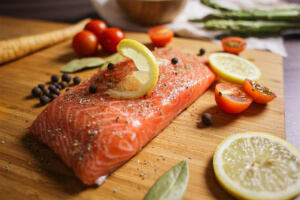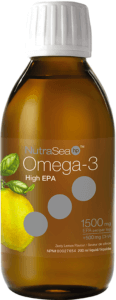Why Are Essential Fatty Acids Important for Healthy Skin?

What are essential fatty acids (EFA’s)?
The human body can synthesize the majority of the fats it needs from the diet; however, sometimes we need a little help… In this case, essential fatty acids are unsaturated fats that must be obtained from food or supplements, because they cannot be manufactured within the body. Essential fatty acids are critical for human health, as they help with brain and nerve function, cell regeneration, and so much more!
There are two types of essential fatty acids, Omega-3 and Omega-6. Both types are classified as “polyunsaturated”, and this is important for your skin because they provide it with much more fluidity and flexibility (think softer). Yet this also means that they are more delicate and liable to damage from oxidation (such as from the elements or the sun). But before we get into the skin further, know this information first…
Omega-3’s
 The three different Omega-3 polyunsaturated fatty acids that are involved with human physiology are as follows:
The three different Omega-3 polyunsaturated fatty acids that are involved with human physiology are as follows:
– Alpha-linolenic acid (ALA): found in plant sources such as nuts and seeds
– Eicosapentaenoic acid (EPA) and Docosahexaenoic acid (DHA): primarily found in certain fish, like salmon, sardine, anchovy and tuna.
EPA and DHA are particularly important as they are both highly anti-inflammatory, and DHA plays important structural roles in our brain. They can be made by the body from ALA, but the extent to which this happens may be quite limited, so best to include a preformed source of EPA/DHA from diet or supplements.
Omega-6’s
Omega-6 fatty acids can be either pro-inflammatory or anti-inflammatory depending on which form is present. The anti-inflammatory form called GLA can actually be very useful for beautifying the skin, and for balancing hormones.
This is why supplements like Evening Primrose Oil or Borage, which contain preformed GLA, have been so popular for things like PMS and menopause. (Preformed GLA is hard to find in our food supply.)
On the other hand, in past years the media has given Omega-6 fats a bad rap due to the fact that the most abundant type in our food supply (called LA or linoleic acid) can be pro-inflammatory. There is a major surplus of this fatty acid in our foods, and the inflammation that results creates havoc, not only in our joints and skin, but in our hormones as well! And as so many women will attest, there is a direct connection between the appearance of our skin and hormone levels.
Are you deficient in Omega-3?
Symptoms of an essential fatty acid deficiency can include:
- Poor memory
- Fatigue
- Dry or inflamed skin
- Poor circulation
- Feeling chronically dehyrated
- Heart problems
- Cognitive issues, including depression and mood swings
Note: several of these challenges can just as easily result from an imbalance between essential fatty acids, i.e. too much Omega-6, and/or a relative deficiency in Omega-3’s.
If you feel like any of the above deficiency symptoms apply, it would be advisable to be more mindful of the fats you are consuming. The solution is to balance the ratio between the fatty acids through the foods and supplements you are consuming. Since, with the exception of GLA, Omega-6 intake is usually more than adequate from diet, we will focus on Omega-3’s, and the importance of getting enough. When assessing your Omega-3 intake, another important thing to keep in mind is how much Omega-6 is in your diet. This is an especially relevant consideration if you are consuming foods with a high Omega-6 fat content, such as:
- Grapeseed oil (9744mg per tablespoon)
- Sunflower Oil (9198mg per tablespoon)
- Corn Oil (7452mg per tablespoon)
- Wheat Germ Oil (7672mg per tablespoon)
- Soybean Oil (7059mg per tablespoon)
- Vegetable Shortening (4771mg per tablespoon)
- Margarine (3323mg per tablespoon)
Want healthier skin? Increase your Omega-3’s!
 If you want to improve your skin, a great place to start is increasing your Omega-3 intake. An easy place to start is by gradually increasing the amount of this fat in your food, by adding a few of the following to your daily diet:
If you want to improve your skin, a great place to start is increasing your Omega-3 intake. An easy place to start is by gradually increasing the amount of this fat in your food, by adding a few of the following to your daily diet:
- Plant fat sources, such as flax seeds, brazil nuts, pumpkin seeds, and walnuts
- Seafood such as mackerel, salmon, tuna, and sardines
- Greens, spinach, kale…(though they don’t actually contain a lot relatively speaking, most is Omega-3)
If you’re not able to eat a lot of Omega-3 foods daily, you might want to consider using a quality Omega-3 supplement. These contain therapeutic amounts of ALA, EPA and DHA, which make fulfilling your daily essential fatty acid requirements a lot easier.
For optimal benefits, choose a quality liquid Omega-3 fish oil in a glass bottle and take with food. Though liquid gel capsules are completely suitable, you need to take a higher amount to reach optimal daily EPA and DHA levels. If you are averse to swallowing capsules, then liquid is easier, and most often tastes fine. (On the other hand, some can’t hack the texture of oil in their mouth, so for these individuals capsules are the way to go!)
What do Omega-3’s Do for the Skin?
Since the skin is the body’s largest organ, the need for balanced nutrition and essential fats is critical for optimal well-being – and this is reflected most visibly through your skin. One of the main reasons essential fats are beneficial for skin health is their ability to reduce inflammation- and many skin issues stem from excessive inflammation, including eczema, psoriasis and acne.
 5 common skin issues that Omega-3’s can help:
5 common skin issues that Omega-3’s can help:
- Acne –improves because of the anti-inflammatory effects of Omega-3.
- Ageing skin – Omega-3’s are responsible for healthy cell membranes and help influence the ability of cells to hold onto water.
- Cellulite – reduces inflammation so allows for better circulation and lymphatic drainage which helps with the appearance of cellulite.
- Dry skin – Omega-3’s act like a natural moisturiser and revitalise skin from the inside out.
- Wrinkles – Omega-3’s nourish the skin, and contribute to the absorption and utilisation of fat-soluble vitamins that help maintain a smooth and elastic texture.
When you have a good balance of essential fatty acids, and are making sure you’re getting adequate Omega-3’s, you’ll gain noticeable benefits, including better brain function, reduced inflammation, better skin health, increased hair growth, accelerated metabolism and reproductive system health. All in all, if you achieve a healthy balance of essential fats, you’ll be on your way to better skin health and also reap the many additional benefits from wiser food choices.
In health,
Graham
